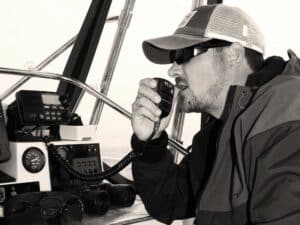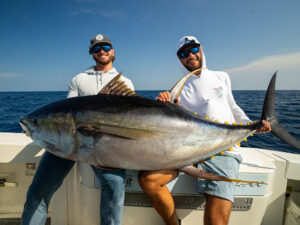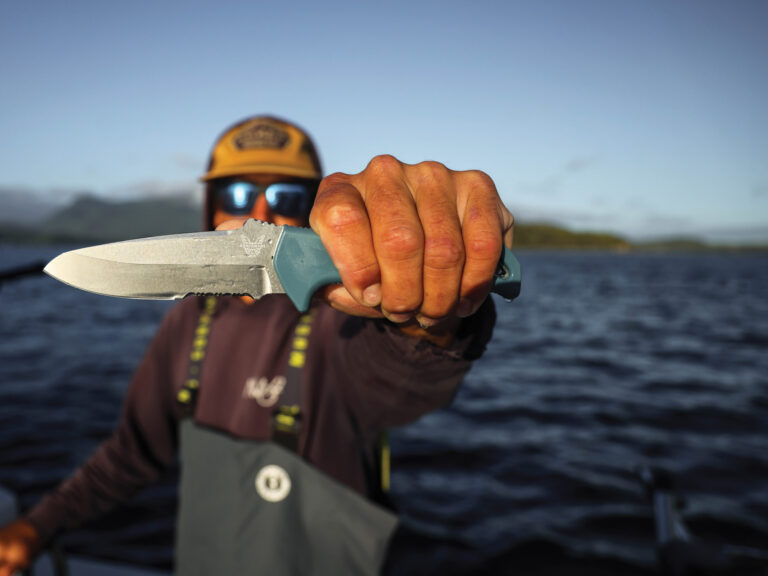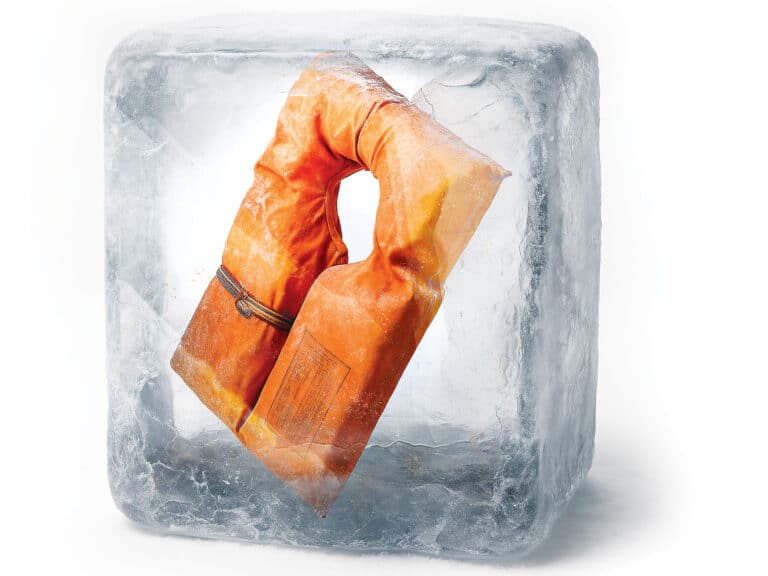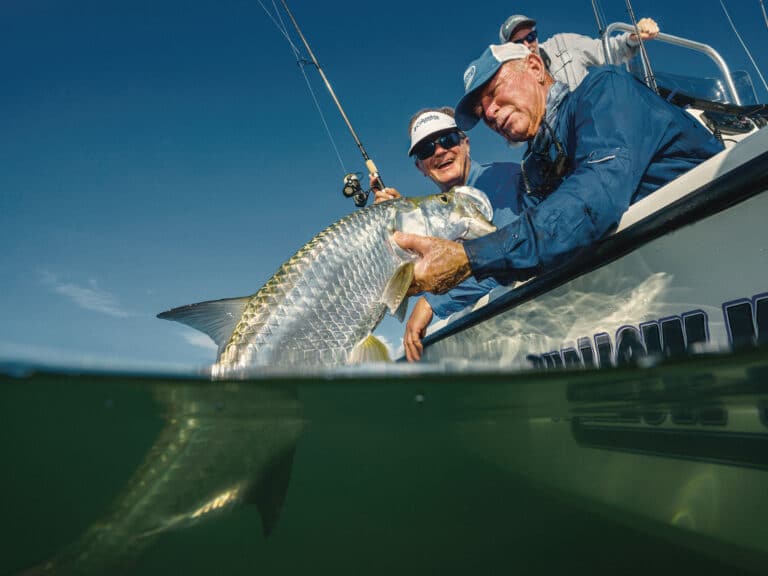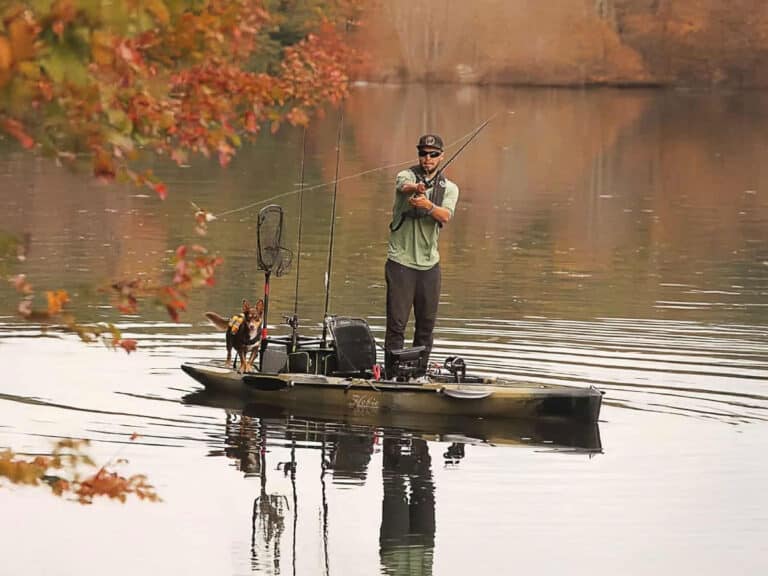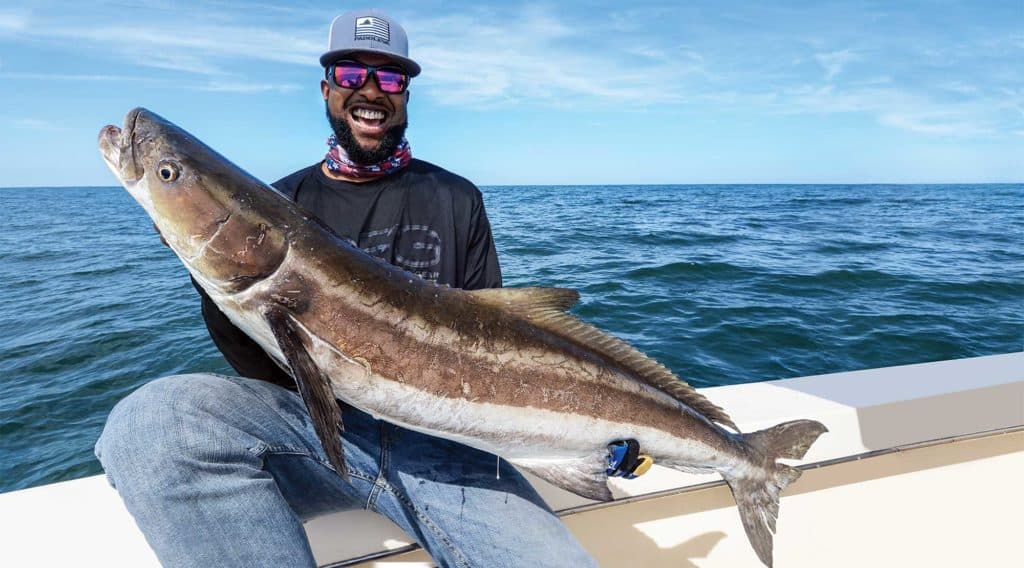
It’s a spring morning, and 10 lines are heavy with yellowfin tuna. Fast forward four months and three anglers are tight to big cobia. Another four months and one angler is working on a big wahoo when another one strikes. Four more months and a furious bluefin tuna attacks a large topwater lure.
This scenario is possible in only one place on Earth: Hatteras Island, North Carolina, a 60-mile-long strip of sand and scrub that juts out into the mid-Atlantic, right at the conjunction of two major currents: the Gulf Stream and Labrador.

Spring Kickoff
It’s early April, and I’m rolling around in the cockpit of Tuna Fever 35 miles off Oregon Inlet, trolling a dozen skirted ballyhoo.
Capt. Billy Maxwell yells against the wind, “There they are!” I follow his pointing arm and spot a squadron of yellowfin tuna swimming along a pronounced color change.
I return my attention to the ballyhoo skipping on the surface when an explosion on the right side of the boat causes the short rigger clip to pop and a reel to scream. Maxwell doesn’t pull the throttles back until 10 rods are bent over with heavy tuna.
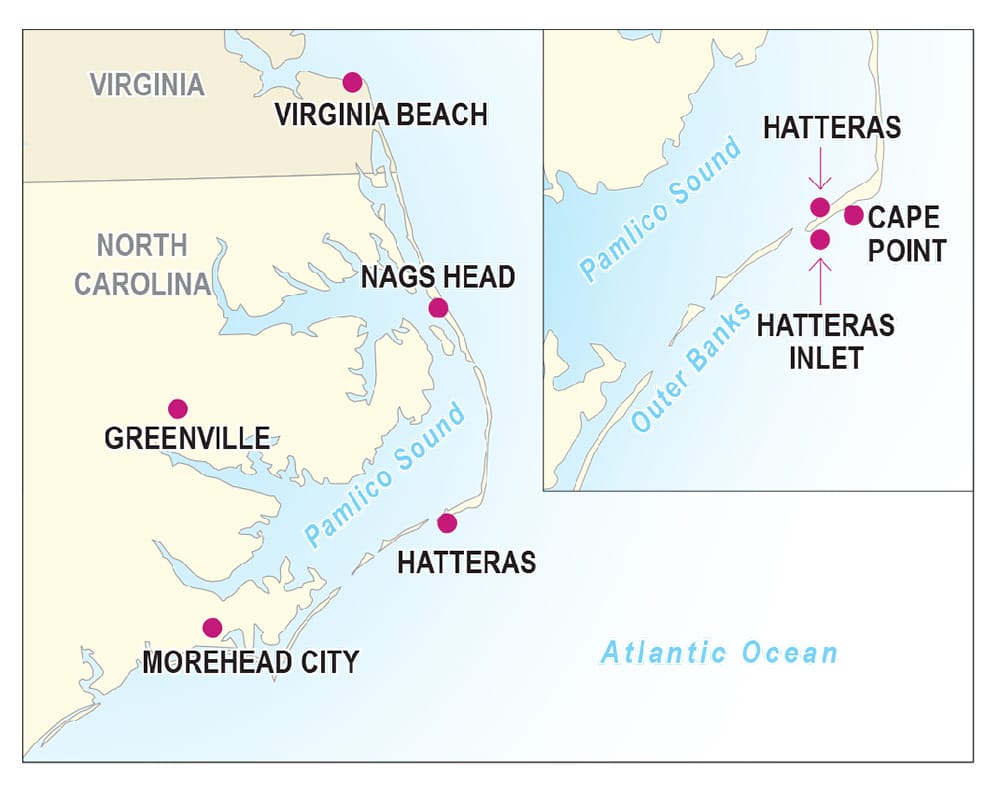
Yellowfin tuna first show up along the edge of the continental shelf, where the warm Gulf Stream meets the cold Labrador Current. The fish haunt the seamounts and valleys along the 100-fathom drop, favoring water temperatures from the upper 60s to lower 70s.
Early in the season, the tuna are content to strike Sea Witches and ballyhoo. As the water warms, the tuna menu switches to flying fish. Then, crews dangle rubber fliers from a kite, and always keep a heavy spinning rod rigged with a large, cup-faced popper to cast at airborne yellow birds.
When the bite is hot, crews limit out on tuna and return to the dock early. As soon as the boat hits the dock, I’m driving south. An hour later, I pull up to Cape Point on the tip of Hatteras Island to surf-fish for monster redfish.
I grab a 12-foot surf rod to join a dozen other anglers lining a sandbar 20 yards off the beach.
I bait the hook with a chunk of menhaden and launch the rig 100 yards into waves. The guy to my left sets the hook as his rod bends over and line pours off his reel. On my right, an angler works a 40-pound redfish into the shallows. As the sun dips below the horizon, the wind picks up a notch, and I hope it will be my turn next.
Hatteras Island hosts the largest red drum in the world. The fish return from their winter grounds in early April and hang around until early summer.
Surf anglers focus on the south-facing beach at Cape Point and Hatteras Inlet, while boaters catch big drum by anchoring along the edge of the shoals in Hatteras Inlet and fishing a chunk of menhaden or mullet on a fish-finder rig.
On clear, sunny days, it pays to slowly motor along the beach or around the inlet mouth, looking for huge schools of redfish on the surface, then launch a 3-ounce bucktail into the melee and hold on tight; if you don’t spook the school, you can follow the fish for miles.

Summer Heats Up
The early-morning sky flecks gold off a glass-calm sea as we troll naked ballyhoo down a sargassum line. One of the outrigger clips pops, then another, and in a few minutes, half a dozen rods bend over with big dolphin dancing in the distance.
As the anglers bring their fish to the boat, Capt. Jason Snead spots more dolphin swimming below the stern. Every free hand grabs a medium-action boat rod rigged with chunks of squid and drops it to the gold-and-green fish dashing behind the boat. In short order, mate Jimmy Hillsman controls the chaos, while anglers bail 20-pound dolphin over the gunwale.
With the fish box writhing neon gold, Snead looks at me and asks, “You want to go cobia fishing?” Never mind we’re 30 miles from the inshore cobia grounds, I shake my head yes.
By the time the sun is high, we’re slowly chugging a mile off the beach, searching the green water for brown cobia swimming on the surface.
“Jason! Jason!” Hillsman screams from the tuna tower. “Stop the boat!” Hillsman rushes to the bow and wings a bucktail that lands a few feet in front of a cobia. The fish turns, lunges and grabs the bright orange bucktail. Hillsman cranks tight, and line peels off the reel.
Two words summarize summer on the Outer Banks: cobia and dolphin. Cobia show up as soon as the inshore water temperature hits 70 degrees. About the same time, dolphin arrive to the long mats of sargassum grass at the edge of the Gulf Stream.
Fishing is better in early summer, when the biggest cobia and dolphin show up. By late summer, smaller dolphin swarm the weed lines, and packs of cobia turn to singles searching the surface for an easy meal.
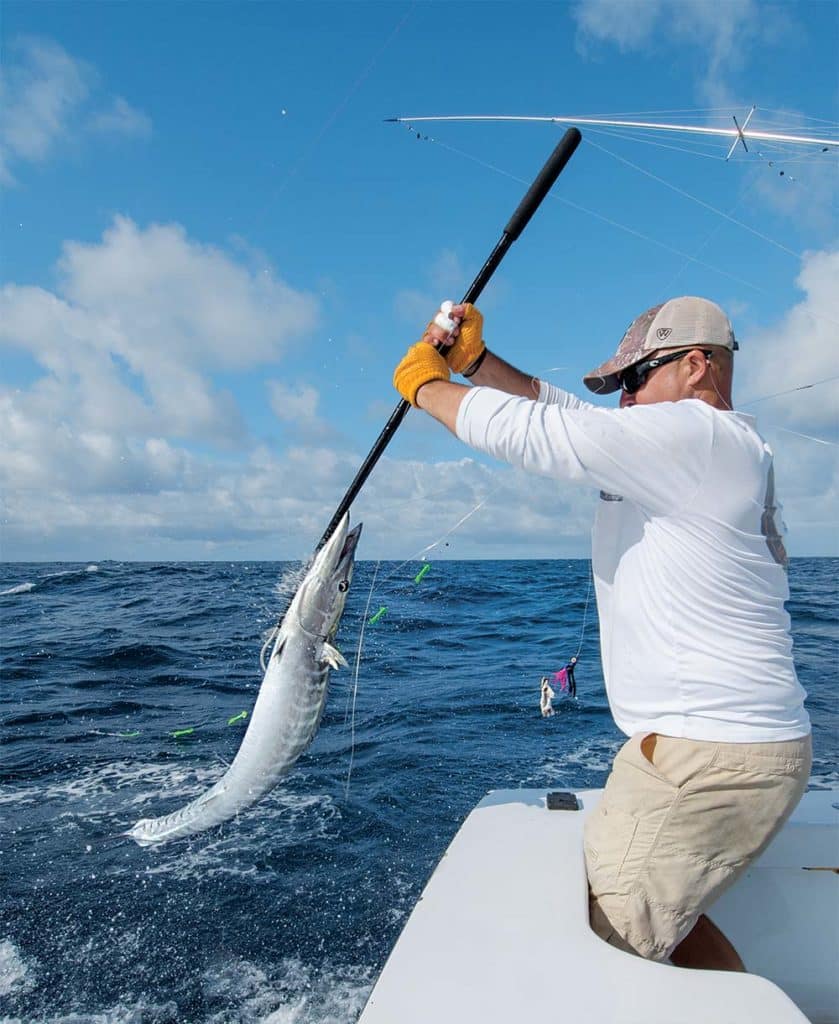
Fall Kicks It in
On Saturday, I’m fishing 15 miles off Hatteras Inlet with Capt. Rom Whitaker IV aboard Release, his father’s 50-foot charter boat. Five miles from the fishing grounds, he slows the boat to 15 knots and instructs us to drop a high-speed trolling lure overboard. A few minutes later, the heavy rod bucks heavily with the weight of a big wahoo.
The next day, I’m fishing from a 20-foot skiff with Capt. Cameron Whitaker, Rom’s brother, 4 miles behind Hatteras Inlet. He drops the anchor on a shallow flat and launches chunks of mullet in every direction. As the sun goes down, the first rod goes off, and a redfish surges toward the horizon. Before I can pull the rod from the holder, three other rods bend and line screams from the reels.
Hatteras’ hottest fishing is in the fall. As the water cools and the days get shorter, summer fish migrate past the island on their way to warmer climes.

The circus starts in early September with the arrival of white marlin off Oregon Inlet. The fish key in on schools of bait riding warm-water eddies that spin down the edge of the continental shelf. Crews pull dredges and teasers to draw white marlin to naked ballyhoo on circle hooks. When the action is on fire and the crews are hot, double-digit flags line the riggers of boats returning to port.
By October, summer is finally over, and yellowfin tuna return to their old haunts off Oregon Inlet. Bigeye tuna are also in the mix. Trolling ballyhoo on Sea Witches and Ilanders at dawn or dusk affords the best shot at being attacked by a gang of bigeyes.
On the Hatteras Inlet side of the island, warm Gulf Stream waters carry big wahoo to the offshore pinnacles and valleys. The best game plan is to roll to the fishing grounds pulling a high-speed trolling lure at 15 knots. Then, at the edge of the shelf, put out a spread of Sea Witches and Ilanders skirted with select ballyhoo rigged on single-strand wire.
At that same time of year, inshore anglers catch red drum and speckled trout behind the island. Searching the grass flats for reds armed with a gold spoon on a medium-action spinning rod, or anchoring up at the edge of a shallow to fish chunks of cut bait on a double-hook bottom rig does the job.
Speckled trout hang out in deep holes in the backwater of the sound or the deep sloughs along the surf line. You catch them with suspending hard baits or a jig rigged with a soft plastic.
Big drum return to the surf and shoals in October, when anglers focus on the north-facing beaches and piers, and the surf at Cape Point and Hatteras Inlet.

Winter Tuna
It’s late January, and I’ve found the best way to stay warm on the Outer Banks: tuna hunting.
We’re drifting over a rock pile in 50 fathoms as the wind blows the sea into a gray froth. Despite the cold, sweat drips down my forehead.
Capt. Jay Daniels calls, “Six colors!” from the bridge of Runaway, a 45-foot classic Carolina boat, and I drop my 7-ounce vertical jig until the color on my depth-coded braid changes six times.
When my jig reaches the ordered depth, I engage the reel and start cranking and jigging the rod tip. On the sixth jerk, my rod stops violently, and the line rips in the opposite direction. From the bend in my rod and burn in my forearms, I can tell it’s a big one.
Blackfin tuna keep anglers warm until the big bluefins show up east of the 100-fathom drop. On a late-winter morning, I’m riding on the bridge of High Return with Capt. David Swain. We’re 30 miles off Oregon Inlet, fishing an area pocked with oily slicks crisscrossed by swirling seabirds.
When a ball of bait shows up on the fish finder, Swain comes off the throttles. In the cockpit, three anglers take turns launching big topwater plugs behind the boat. A nervous silence consumes the crew until a huge explosion breaks it.
The angler holds tight while the line disappears from his spinning reel. The next 40 minutes are a give-and-take battle that brings a 200-pound bluefin to the back of the boat. The angler is exhausted, but the fish still has some fight; it makes a final violent surge, breaking the line and the angler’s heart.
Big bluefins draw a lot of attention to the Outer Banks, where the basic trolling setup of local crews is a 130-pound rod and reel rigged with a horse ballyhoo and heavy Hawaiian Eye.
But when the fish get finicky, nothing fires them up like a big rubber squid dangling from a green stick. Don’t have a green stick? Don’t worry, the light touch of a 12-inch stickbait on an extra-heavy spinning outfit can be just the trick.
SWS Planner
What: Inshore and offshore trophy fishing
When: Year-round
Who: The following Outer Banks charter captains know where and when to find the hot bite.
Oregon Inlet
Capt. David Swain
High Return
fishhighreturn.com
252-473-6268
Capt. Jason Snead
Dream Girl
dreamgirlcharters.com
252-255-8037
Hatteras Inlet
Capt. Jay Daniels
Runaway
wefishobx.com
252-489-3646
Capt. Rom Whitaker Jr.
hatterasharbor.com
252-305-5229
Capt. Cameron Whitaker
traditionfishing.com
252-305-7755



